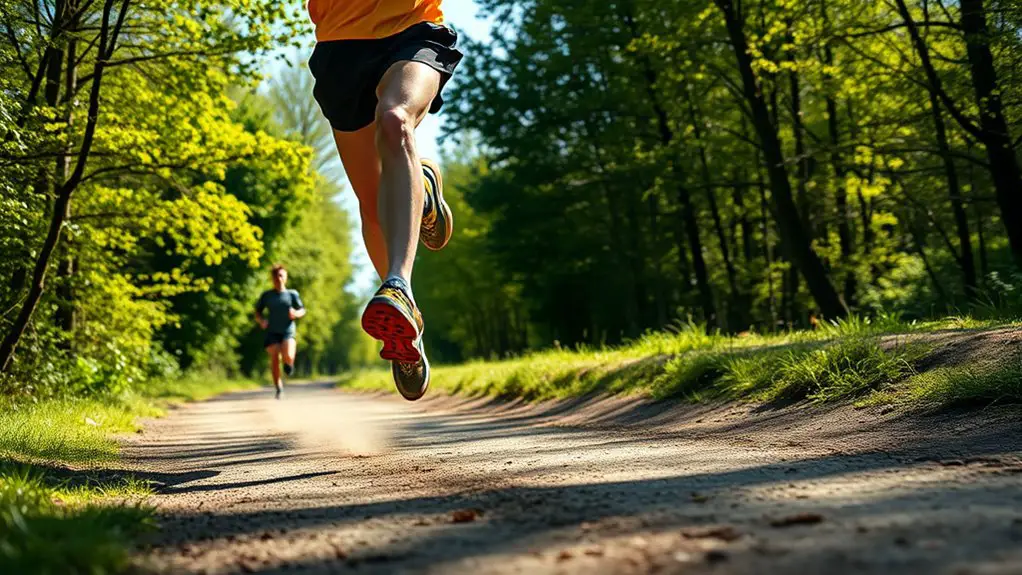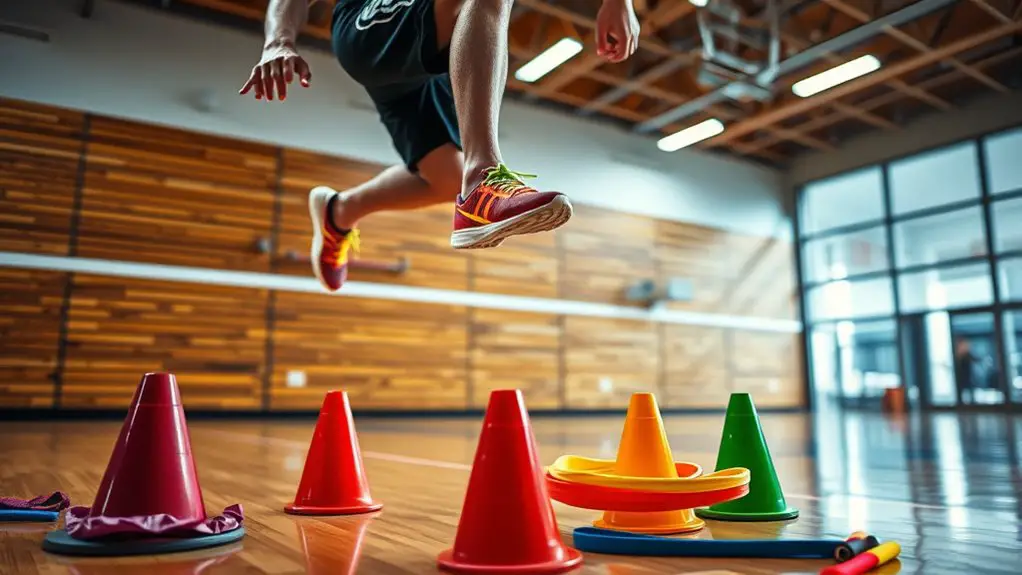To improve your stride length and frequency in running, focus on maintaining proper form and engage your core. Work on techniques like hip extension and synchronized arm swings. Incorporate exercises like high knees and butt kicks to enhance your leg turnover. Strength training will boost power and flexibility work will enhance your range of motion. Pay attention to your cadence and consider how terrain affects your performance. Keep going to discover more tips for enhancing your runs.
Understanding Stride Length and Frequency
When it comes to running, stride length and frequency are two critical components that can greatly impact your performance. Stride length refers to the distance covered in one step, while frequency is the number of steps you take per minute. Balancing these two elements can release your potential and make each run feel more liberating.
Increasing your stride length can enhance your speed, letting you cover more ground with each step. However, if you stretch too far, you risk losing efficiency and inviting injury. On the flip side, higher frequency keeps your momentum up and helps maintain a rhythm that can feel exhilarating. Incorporating acceleration drills into your training can further improve both stride length and frequency.
Experiment with both aspects; find what feels right for your body. By understanding and adjusting your stride length and frequency, you'll not only run faster but also enjoy the freedom of movement that comes with it. Embrace the journey, and let your legs lead the way!
The Importance of Proper Running Form
While you might focus on stride length and frequency to improve your running performance, proper running form is equally essential for maximizing efficiency and reducing the risk of injury. Think about how your body moves; when you maintain an upright posture, engage your core, and keep your shoulders relaxed, you create a powerful foundation. A strong form allows your muscles to work together harmoniously, which can boost your speed and endurance.
Additionally, landing on your midfoot rather than your heel helps absorb impact, making each stride feel lighter. This not only lessens strain on your joints but also lets you run longer without fatigue. Remember, it's not just about how far or fast you go; it's about enjoying the freedom of movement. By honing your running form, you'll discover a more fluid, efficient way to cover distances, allowing you to truly embrace the joy of running. A strong core is essential for stabilizing the body during physical activities, enhancing your overall performance.
Techniques to Increase Stride Length
Having established the significance of proper running form, let's explore how you can effectively increase your stride length. One key technique is to focus on your hip extension. By engaging your glutes and driving your hips forward, you'll naturally lengthen each stride. Try running with a slight forward lean, which can help you cover more ground effortlessly.
Another useful method is to work on your arm swing. Your arms should move in sync with your legs; a powerful arm swing can propel your legs further back, enhancing your stride.
Additionally, consider practicing running drills, like high knees or butt kicks, to improve your leg mechanics. Finally, don't forget about your footwear. Choose shoes that support your stride and allow for a natural range of motion. With these techniques, you'll feel that exhilarating freedom of running with longer strides. Incorporating strength training for runners can further enhance your overall running mechanics and efficiency.
Exercises to Enhance Stride Frequency
To boost your stride frequency, incorporating specific exercises into your routine can make a significant difference. Start with high knees; they'll elevate your heart rate and engage your hip flexors, helping you develop faster leg turnover. Next, try butt kicks, which promote quick leg recovery and improve your overall running rhythm.
Plyometric drills, like jump squats and bounding, can also enhance your explosive power, leading to quicker strides. Don't forget to include short sprints; they'll train your muscles to adapt to faster speeds. Finally, consider agility ladder drills to improve coordination and foot speed, which can directly impact your stride frequency. Additionally, plyometrics improve coordination and can further enhance your overall running efficiency.
Mix these exercises into your weekly training, and you'll notice a shift in your running dynamics. It's all about finding what works for you and embracing the freedom to explore different movements. Enjoy the journey to a more efficient stride!
The Role of Cadence in Running Efficiency
Understanding cadence is essential for improving your running efficiency, as it directly influences how you move and conserve energy. By finding your ideal cadence, you can experience a liberating rhythm that makes each run feel effortless. A higher cadence can reduce the risk of injury, enhance speed, and help you maintain a steady pace. This improvement in cadence can also lead to enhancements in muscle efficiency, allowing you to use oxygen more effectively during your runs.
Here's a quick look at how cadence impacts your running experience:
| Cadence (steps/min) | Feelings Experienced |
|---|---|
| 150 | Heavy, labored movements |
| 160 | Moderate, steady flow |
| 170 | Light, breezy strides |
| 180 | Effortless, flowing motion |
| 190 | Free, exhilarating experience |
Experimenting with your cadence can release a newfound freedom in your runs. So, pay attention to your steps and embrace the beautiful dance of running!
How to Use Interval Training for Improvement
While many runners focus on distance and endurance, incorporating interval training can greatly boost your performance. By alternating between high-intensity bursts and lower-intensity recovery periods, you can enhance your stride length and frequency. Start with a warm-up, then choose a distance or time for your sprints—think 30 seconds or 200 meters. Push yourself hard during those intervals, aiming for a pace that challenges you. Follow each sprint with a recovery jog or walk for about the same duration.
This method not only improves your speed but also builds your aerobic capacity, allowing you to run faster without sacrificing endurance. You can mix things up by adjusting the intervals or incorporating hill sprints. The beauty of interval training lies in its flexibility; you can tailor it to fit your lifestyle and running goals. By engaging in high-intensity interval training, you can further maximize your workout's effectiveness. So, embrace it, and watch your stride and frequency soar!
The Impact of Terrain on Stride and Frequency
As you navigate different terrains, you'll notice how each surface can considerably influence your stride length and frequency. Running on soft grass or sand typically forces you to shorten your stride, as these surfaces absorb impact and can slow you down. However, when you're on a smooth, hard surface, like asphalt, you can open up your stride and increase your frequency, enjoying that exhilarating feeling of speed.
Trail running presents another challenge—roots, rocks, and uneven ground require you to adapt quickly, often leading to shorter, quicker strides to maintain balance. Embracing these variations can enhance your running experience, allowing you to connect with nature while developing your skills. Staying properly hydrated during these runs is crucial for maintaining energy and focus, ensuring you can tackle any terrain effectively.
Experimenting with different terrains not only keeps your routine fresh but also helps you discover what feels best for your body. So, mix it up, and let the terrain guide your stride and frequency!
Incorporating Strength Training Into Your Routine
Incorporating strength training into your running routine can considerably enhance your stride length and frequency. By building muscle strength, you'll improve your overall power, allowing for longer and quicker strides. Focus on exercises that target your core, legs, and hips, as these are essential for running efficiency. Additionally, incorporating squats and deadlifts into your regimen will help develop the necessary strength for optimal performance.
Here's a simple strength training routine you can try:
| Exercise | Reps/Duration |
|---|---|
| Squats | 3 sets of 10-15 |
| Deadlifts | 3 sets of 8-12 |
| Lunges | 3 sets of 10-12 per leg |
Incorporating these exercises into your weekly routine will not only make you a stronger runner but also give you the freedom to explore longer distances and varied terrains. So don't shy away from strength training; it's a key component of your running success.
The Benefits of Flexibility and Mobility Work
Flexibility and mobility work is essential for any runner looking to improve their stride length and frequency. When you incorporate stretching and dynamic movements into your routine, you're not just preventing injuries; you're also enhancing your body's range of motion. This freedom of movement allows you to extend your stride more naturally, letting you cover ground with ease.
By increasing your flexibility, you can reduce muscle tightness that often limits your running efficiency. Improved mobility means your joints can move freely, enabling you to maintain a fluid motion throughout your run. This translates to quicker turnover rates, as your body can respond better to changes in pace and terrain. Additionally, mobility training enhances range of motion, which is crucial for optimizing your running mechanics.
A well-rounded flexibility routine helps you recover faster, keeping you on the trail longer. Embrace these practices, and you'll find yourself running with a newfound sense of liberation, feeling empowered by each stride you take.
Monitoring Progress and Making Adjustments
To truly enhance your stride length and frequency, it's crucial to monitor your progress and make necessary adjustments along the way. By tracking your workouts, you can uncover patterns and identify areas that need improvement. Embrace the freedom that comes from understanding your body's response to training.
| Week | Distance (miles) | Stride Length (inches) |
|---|---|---|
| 1 | 10 | 28 |
| 2 | 12 | 29 |
| 3 | 14 | 30 |
| 4 | 16 | 31 |
| 5 | 18 | 32 |
Notice how small changes can lead to significant gains. If you're plateauing, shake things up! Adjust your tempo runs, incorporate intervals, or even focus on your breathing. Stay aware of your body's signals, and don't hesitate to modify your training plan. This journey is about finding your rhythm and celebrating your progress!
Frequently Asked Questions
How Can Diet Impact My Running Stride and Frequency?
Your diet's essential for your running performance. Proper nutrition fuels your energy, supports muscle recovery, and enhances endurance. If you're not eating right, it could hinder your stride and overall running efficiency. Balance is key!
What Footwear Is Best for Improving Stride Length and Frequency?
When it comes to finding the right footwear, think of it as choosing a partner for a dance. Light, flexible shoes that support your natural movement can help you glide effortlessly, enhancing your stride and rhythm.
Can Age Affect My Running Stride and Frequency?
Yes, age can affect your running stride and frequency. As you get older, muscle strength and flexibility might decrease, which can lead to changes in your form. Staying active helps maintain your running efficiency.
Should I Consider Altitude Training for Better Stride Performance?
Think of a bird soaring higher, catching thermals effortlessly. Altitude training might just give you that advantage. It can enhance lung capacity and efficiency, so if you're seeking freedom in your stride, it's worth considering.
How Does Hydration Influence My Running Efficiency and Stride?
Hydration's essential for your running efficiency. When you're well-hydrated, your muscles function better, reducing fatigue. Dehydration can hinder your performance, causing you to struggle with maintaining a steady stride and overall stamina during runs.




